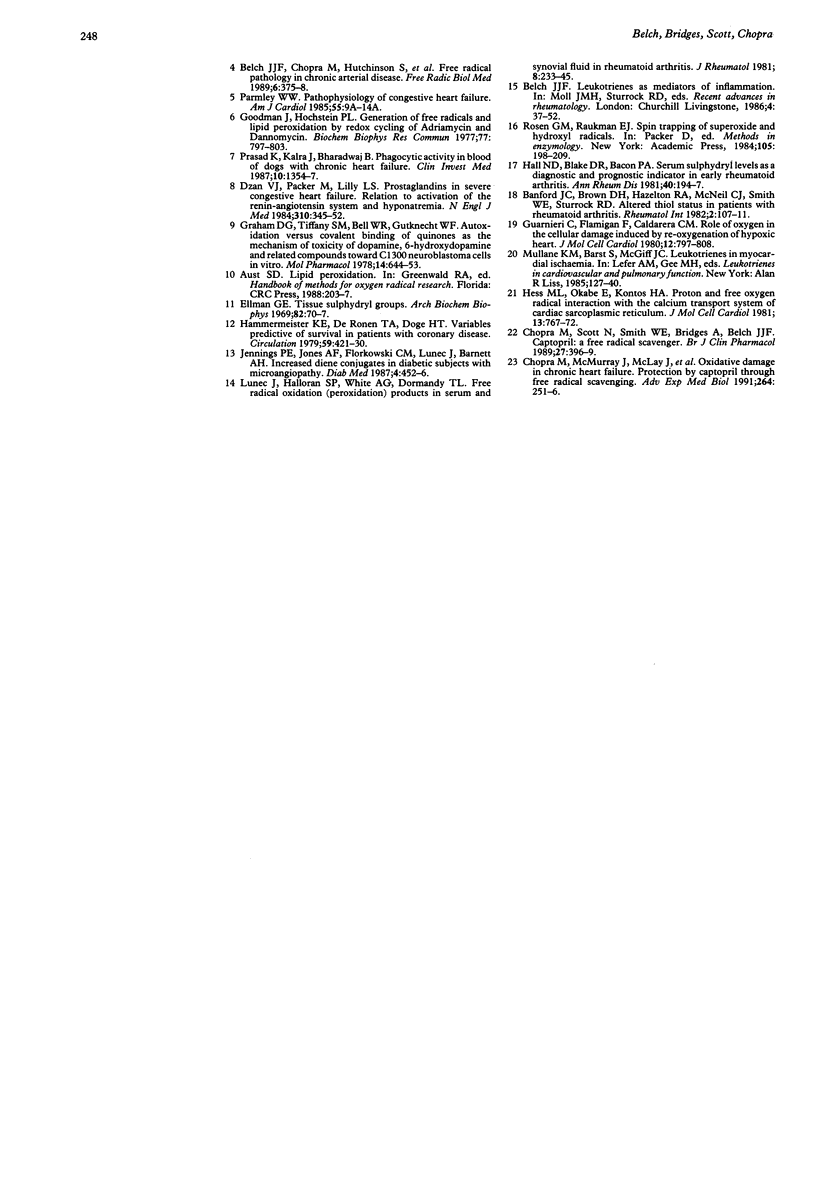Abstract
Plasma lipid peroxides (malondialdehyde) and thiols were measured in 45 patients with congestive heart failure and 45 controls. Malondialdehyde concentrations were significantly higher in the patients with congestive heart failure (median 9.0 nmol/ml interquartile range (IQR) 7.9-10.2) than in the controls (median 7.7 nmol/ml (IQR 6.9-9.2)). Plasma thiols were significantly lower in congestive heart failure (median 420 mumol/l (IQR 379-480)) than in the controls (median 463 mumol/l (IQR 445-525)). There was a significant but weak negative correlation between malondialdehyde and left ventricular ejection fraction (r = -0.35) and a positive correlation between plasma thiols and left ventricular ejection fraction (r = 0.39). This study provides clinical support for experimental data indicating that free radicals may be important in heart failure. It also suggests that the degree of free radical production may be linked to the severity of the disease.
Full text
PDF



Selected References
These references are in PubMed. This may not be the complete list of references from this article.
- Banford J. C., Brown D. H., Hazelton R. A., McNeil C. J., Smith W. E., Sturrock R. D. Altered thiol status in patients with rheumatoid arthritis. Rheumatol Int. 1982;2(3):107–111. doi: 10.1007/BF00541162. [DOI] [PubMed] [Google Scholar]
- Belch J. J., Chopra M., Hutchison S., Lorimer R., Sturrock R. D., Forbes C. D., Smith W. E. Free radical pathology in chronic arterial disease. Free Radic Biol Med. 1989;6(4):375–378. doi: 10.1016/0891-5849(89)90082-8. [DOI] [PubMed] [Google Scholar]
- Chopra M., McMurray J., McLay J., Bridges A., Scott N., Smith W. E., Belch J. J. Oxidative damage in chronic heart failure: protection by captopril through free radical scavenging? Adv Exp Med Biol. 1990;264:251–255. doi: 10.1007/978-1-4684-5730-8_40. [DOI] [PubMed] [Google Scholar]
- Chopra M., Scott N., McMurray J., McLay J., Bridges A., Smith W. E., Belch J. J. Captopril: a free radical scavenger. Br J Clin Pharmacol. 1989 Mar;27(3):396–399. doi: 10.1111/j.1365-2125.1989.tb05384.x. [DOI] [PMC free article] [PubMed] [Google Scholar]
- ELLMAN G. L. Tissue sulfhydryl groups. Arch Biochem Biophys. 1959 May;82(1):70–77. doi: 10.1016/0003-9861(59)90090-6. [DOI] [PubMed] [Google Scholar]
- Goodman J., Hochstein P. Generation of free radicals and lipid peroxidation by redox cycling of adriamycin and daunomycin. Biochem Biophys Res Commun. 1977 Jul 25;77(2):797–803. doi: 10.1016/s0006-291x(77)80048-x. [DOI] [PubMed] [Google Scholar]
- Graham D. G., Tiffany S. M., Bell W. R., Jr, Gutknecht W. F. Autoxidation versus covalent binding of quinones as the mechanism of toxicity of dopamine, 6-hydroxydopamine, and related compounds toward C1300 neuroblastoma cells in vitro. Mol Pharmacol. 1978 Jul;14(4):644–653. [PubMed] [Google Scholar]
- Guarnieri C., Flamigni F., Caldarera C. M. Role of oxygen in the cellular damage induced by re-oxygenation of hypoxic heart. J Mol Cell Cardiol. 1980 Aug;12(8):797–808. doi: 10.1016/0022-2828(80)90081-4. [DOI] [PubMed] [Google Scholar]
- Hammermeister K. E., DeRouen T. A., Dodge H. T. Variables predictive of survival in patients with coronary disease. Selection by univariate and multivariate analyses from the clinical, electrocardiographic, exercise, arteriographic, and quantitative angiographic evaluations. Circulation. 1979 Mar;59(3):421–430. doi: 10.1161/01.cir.59.3.421. [DOI] [PubMed] [Google Scholar]
- Hess M. L., Okabe E., Kontos H. A. Proton and free oxygen radical interaction with the calcium transport system of cardiac sarcoplasmic reticulum. J Mol Cell Cardiol. 1981 Aug;13(8):767–772. doi: 10.1016/0022-2828(81)90258-3. [DOI] [PubMed] [Google Scholar]
- Jennings P. E., Jones A. F., Florkowski C. M., Lunec J., Barnett A. H. Increased diene conjugates in diabetic subjects with microangiopathy. Diabet Med. 1987 Sep-Oct;4(5):452–456. doi: 10.1111/j.1464-5491.1987.tb00908.x. [DOI] [PubMed] [Google Scholar]
- Lunec J., Halloran S. P., White A. G., Dormandy T. L. Free-radical oxidation (peroxidation) products in serum and synovial fluid in rheumatoid arthritis. J Rheumatol. 1981 Mar-Apr;8(2):233–245. [PubMed] [Google Scholar]
- McCord J. M. Oxygen-derived free radicals in postischemic tissue injury. N Engl J Med. 1985 Jan 17;312(3):159–163. doi: 10.1056/NEJM198501173120305. [DOI] [PubMed] [Google Scholar]
- Packer M. Sudden unexpected death in patients with congestive heart failure: a second frontier. Circulation. 1985 Oct;72(4):681–685. doi: 10.1161/01.cir.72.4.681. [DOI] [PubMed] [Google Scholar]
- Rosen G. M., Rauckman E. J. Spin trapping of superoxide and hydroxyl radicals. Methods Enzymol. 1984;105:198–209. doi: 10.1016/s0076-6879(84)05026-6. [DOI] [PubMed] [Google Scholar]


